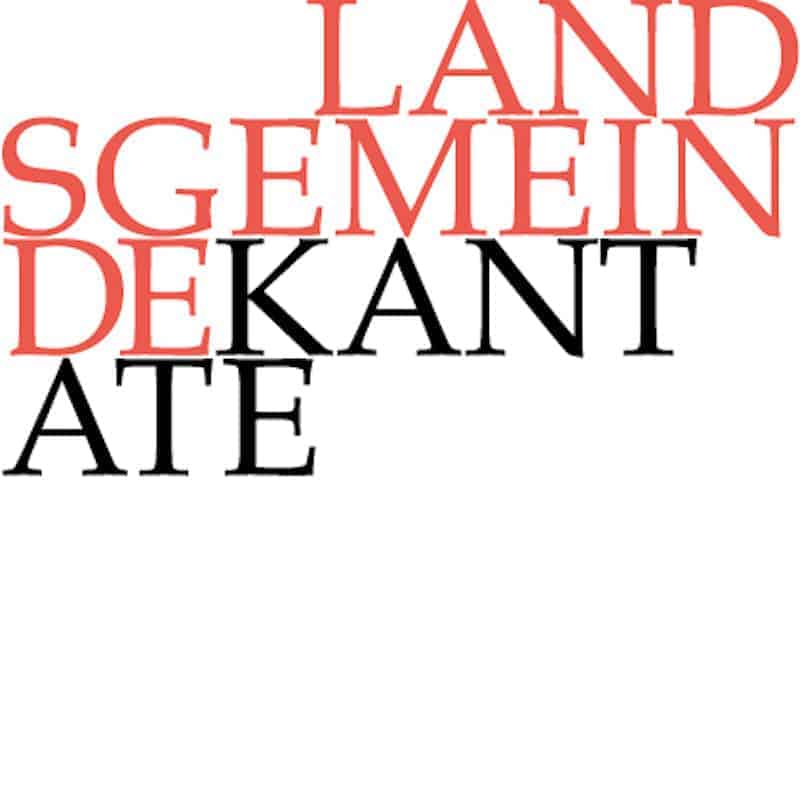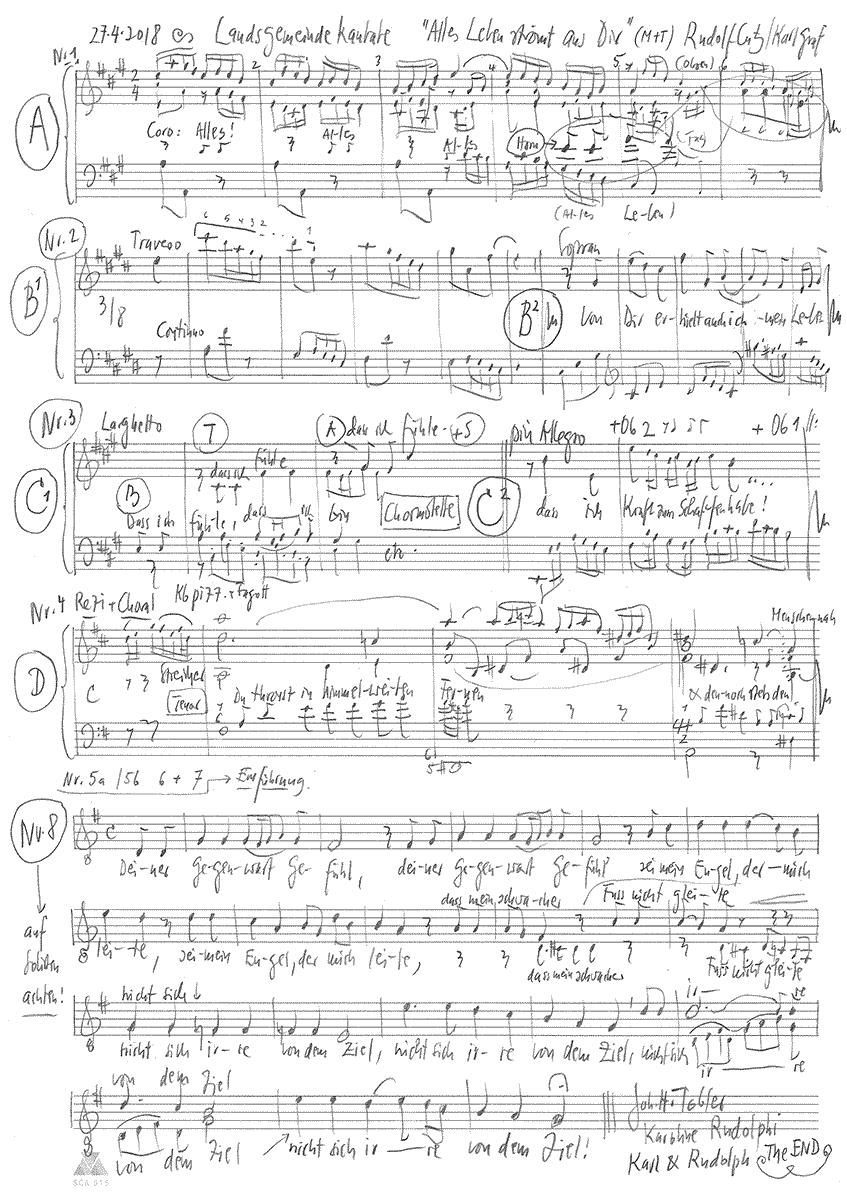Landsgemeindekantate «Alles Leben strömt aus dir»
for soprano, alto, tenor and bass, vocal ensemble and orchestra
The Swiss town of Trogen and its main square situated in front of the church are traditionally associated with the Landsgemeinde assemblies of the canton of Appenzell Ausserrhoden – and thus with the hymn “Ode an Gott” (Ode to God) sung at the beginning of each assembly. And over the last ten years, since the J. S. Bach Foundation and its ensemble conducted by Rudolf Lutz have been performing in the church, the town has also become closely associated with the sacred oeuvre of Johann Sebastian Bach.

Would you like to enjoy our videos ad-free? Subscribe to YouTube Premium now...
Workshop
Reflective lecture
Choir
Soprano
Jessica Jans, Jennifer Ribeiro Rudin, Simone Schwark, Susanne Seitter, Noëmi Sohn Nad, Noëmi Tran Rediger
Alto
Antonia Frey, Stefan Kahle, Alexandra Rawohl, Lisa Weiss, Sarah Widmer
Tenor
Marcel Fässler, Clemens Flämig, Christian Rathgeber, Sören Richter
Bass
Fabrice Hayoz, Daniel Pérez, Philippe Rayot, Jonathan Sells, William Wood
Orchestra
Conductor
Rudolf Lutz
Violin
Renate Steinmann, Monika Baer, Claire Foltzer, Olivia Schenkel, Marita Seeger, Salome Zimmermann
Viola
Susanna Hefti, Matthias Jäggi, Martina Zimmermann
Violoncello
Martin Zeller, Hristo Kouzmanov
Violone
Markus Bernhard
Oboe
Kerstin Kramp, Ingo Müller
Bassoon
Susann Landert
Transverse flute
Tomoko Mukoyama
Corno
Olivier Picon
Organ
Nicola Cumer
Harpsichord
Thomas Leininger
Musical director & conductor
Rudolf Lutz
Workshop
Participants
Karl Graf, Rudolf Lutz
Reflective lecture
Speaker
Roland Inauen
Recording & editing
Recording date
04/27/2018
Recording location
Trogen AR (Schweiz) // Evangelische Kirche
Sound engineer
Stefan Ritzenthaler, Nikolaus Matthes
Director
Meinrad Keel
Production manager
Johannes Widmer
Production
GALLUS MEDIA AG, Switzerland
Producer
J.S. Bach Foundation of St. Gallen, Switzerland
Librettist
Text
Johann Heinrich Tobler and Karl Graf
First performance
27 April 2018, ev. Kirche Trogen AR, Switzerland
In-depth analysis
This dual musical relationship inspired both the idea of a new composition to pay homage to the hymn – which holds personal significance for composer Rudolf Lutz – and the decision to base the work on the style of Bach’s chorale cantatas. This choice posed challenges, not least because Bach’s oeuvre stands in pointed contrast to the compositional period and classical-romantic style of the Landesgemeinde hymn. At the same time, however, it placed the whole gamut of highbaroque compositional forms and chorale treatment at the disposal of Rudolf Lutz, whose new composition also echoes the compact symphonic idiom of Haydn and the atmospheric choral treatment of Mendelssohn.
The introductory chorus, a powerful concertante orchestral setting, opens with mighty choral calls and a thematic horn signal ere the vocal parts enter into a flexible movement that is divided into distinct, melismatic lines. The second movement, an aria set as a trio for soprano, transverse flute and continuo, interprets all life as a gift from above, a message that is enhanced not only by the fragile flute timbre and elegiac mood but also by the descending gesture that draws on the last line of the chorale verse. The third movement, a chorale fughetta with subtle layering of parts, returns to the hymn text and its message of deep gratitude, while the episodes for alto and oboe trio express the spirit and energy that this engenders. The recitative and arioso, movement number four, is opened by the tenor soloist and inspired by the tone of Bach’s Passion compositions. This setting musically reveals the source of human freedom as lying in the dichotomy of external distance to God and internal closeness to God in suffering, before yielding to a distinctly romantic and soulful vocal style with the entry of a low choir (ATTBB) on the line of “Welch ein Trost” (what a comfort).
The rich wind setting of the aria “Welch ein Vorrecht ist’s zu leben” (what a privilege it is to live) provides a vibrant backdrop for the bass soloist whose peasant-heroic attitude and occasional buffoonish gestures round out a setting that confirms the blessings of peace and freedom as a true source of joy. It is a distinctly sturdy but thoroughly polyphonic setting in which melodic fragments of the hymn abound. The ensuing “song of joy”, assigned to a vocal terzet of soprano, alto and tenor, presents an Appenzell country waltz, complete with an even-metred “Tempo di Schottische” inserted in the middle section and a closing coda. In good baroque-suite style, the music of this movement gives a good-natured nod to the folk heritage of the region.
The ensuing bass recitative – a strict sermon – gains considerable traction through the addition of strings and woodwinds, ere the soprano and alto duet “O so gib, dass rein und wahr” (O give us, that pure and true) evokes through muted strings and high basset scoring the ethereal charm of the Landsgemeindelied, which, despite its tradition as a hymn, is in essence a heartfelt prayer. In this movement, the airiness and sweetness of the part writing, reminiscent of Corelli, subtly enhance the text’s concerns of all-too-human artifice. The closing verse, by contrast, builds on the sense of identity and community that this hymn – a song both religious and political – inspires. The movement opens with a pre-emptive, imploring rendition of the last two lines of text before presenting the full verse in an expansive double choir; in good Bach-like fashion, the higher number of voices raises not only the fullness of sound, but through the heightened harmonic beauty also the spiritual import of the music.
With its interplay of poetry and music, the cantata – dedicated to Konrad and Elizabeth Hummler – can thus be appreciated as an endeavour to meld respect for the origins and history of the hymn with a new compositional interpretation. It is a work that bestows on the Landsgemeindelied both the richness of textual-theological interpretation and the subtly concertante musical shading that Bach and his librettists also used in their treatment of the Protestant chorale tradition. The established compositional style and traditional forms of Bach’s era mark out – akin to slalom gates on a ski piste – a clear, fixed path, while allowing too for joyous free runs into unmapped territory.
Libretto
1. Chor
Alles Leben strömt aus dir
und durchwallt in tausend Bächen
alle Welten; alle sprechen:
Deiner Hände Werk sind wir.
2. Arie — Sopran
Von dir erhielt auch ich mein Leben.
Du hast mir Seele und Verstand
und mit den Werken deiner Hand
ein Zeugnis deiner Huld gegeben.
3. Choral und Rezitativ
Dass ich fühle, dass ich bin,
dass ich Kraft zum Schaffen habe,
kommt von dir, ist deine Gabe,
dass ich dich, du Grosser, kenne,
dass ich froh dich Vater nenne,
lässt mich dir allein vertrauen
und auf deine Gnade bauen,
o ich sinke vor dir hin.
4. Rezitativ und Arioso — Tenor
Du thronst in himmelweiten Fernen,
bist dennoch stets den Menschen nah.
Du kennst der Menschen Tun allda
und lässt sie wahre Freiheit lernen.
Von dir kommt Kraft zum rechten Leben
in Liebe, Treu und Redlichkeit.
Es ist mein Schicksal allezeit
in deine Vaterhand gegeben;
welch ein Trost! – Und unbegrenzt
und unnennbar ist die Wonne,
dass, gleich deiner milden Sonne,
mich dein Vateraug‘ umglänzt.
5. a. Arie — Bass
5. b. Terzett — Sopran, Alt, Tenor
(Tempo di «Wälserli» e di «Schottisch»)
Welch ein Vorrecht ist’s zu leben,
wo Friede herrscht und Freiheit gilt!
Drum Freudenstimmen sich erheben
im Klang, der aus den Herzen quillt,
mit Liedern und mit Jauchzern viel,
mit Schellen- und mit Saitenspiel.
6. Rezitativ — Bass
Die Gaben, die du mir, o Gott, gegeben,
die helfen mir zum Dienst an Volk und Land,
die Pflichten gern zu tun in meinem Stand,
und leiten mich zur Ehrfurcht vor dem Leben.
So lass mich, was zu tun ist, recht besorgen.
Denn einmal muss ich Rechenschaft ablegen
von Wort und Tat auf meinen Lebenswegen.
Dann bleibt von meinem Tun dir nichts verborgen.
7. Duett (Sopran, Alt), Soli & Chor
O so gib, dass rein und wahr,
frei von Künstelei und Ränken,
all mein Tun und all mein Denken
vor dir bleibe immerdar.
8. Schlusschoral
Deiner Gegenwart Gefühl
sei mein Engel, der mich leite,
dass mein schwacher Fuss nicht gleite,
nicht sich irre von dem Ziel.



